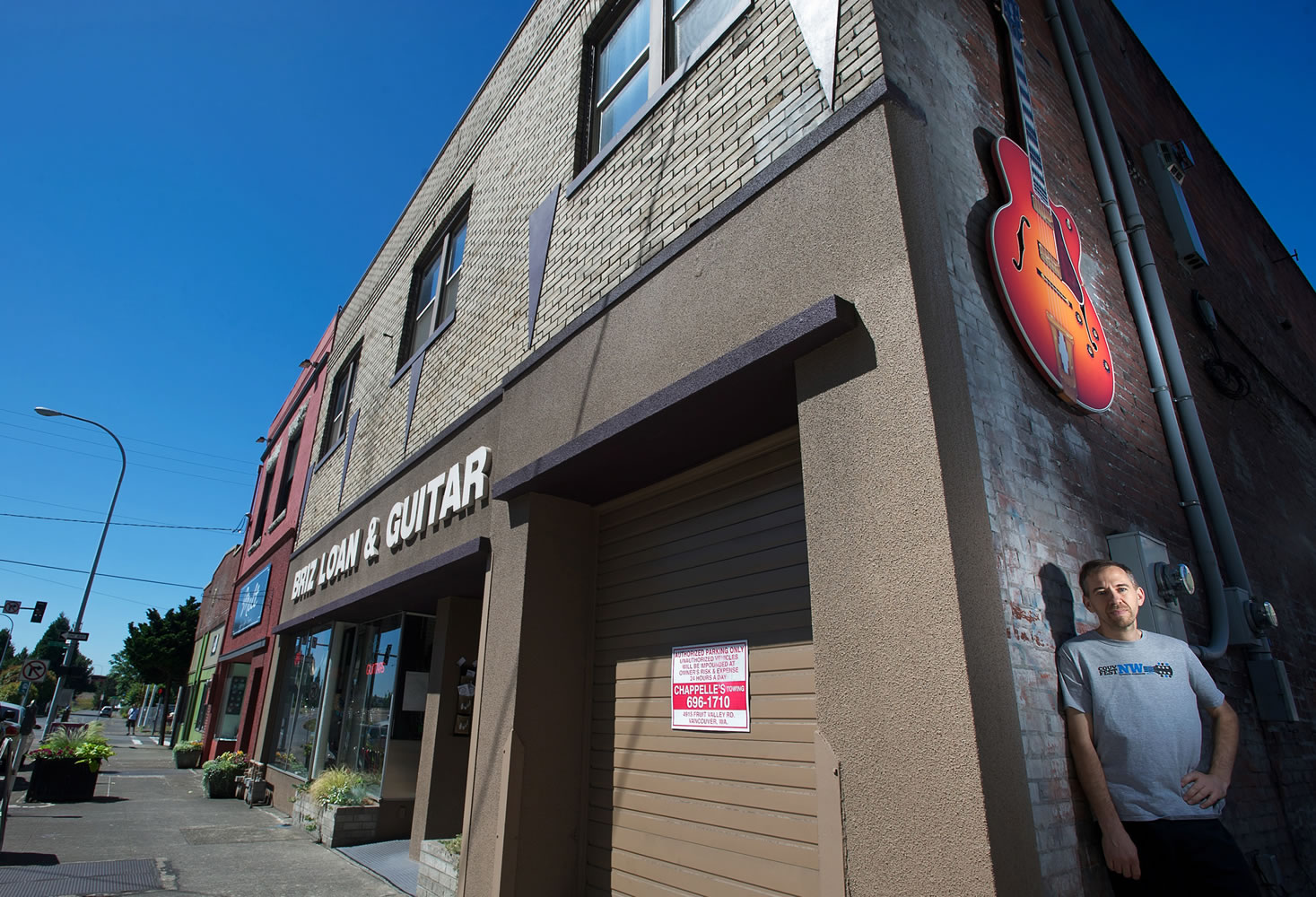Matt Brislawn’s guitar shop sits near the entrance to the Interstate 5 Bridge in downtown Vancouver, a location he has worried about through years of public planning to replace the aged crossing and add light rail lines through the heart of the city.
The project’s recent cancellation now has Brislawn mapping out his own strategy for the historic building he owns for his business, Briz Loan & Guitar, a pawn shop for instruments. Brislawn, who in February gathered 50 signatures on a letter asking lawmakers to halt the bridge project, says he may now invest in a two-story fresco for a bare exterior wall of his structure at 506 Washington St.
He’d been asked last year to enroll his building in a downtown mural project. But back then, Brislawn wasn’t sure his property would be visible next to the planned rise of a freeway ramp for light-rail tracks to enter the new bridge.
“I’m completely relieved that the looming threat is no longer hanging over our business and building,” he said.
The proposed $3.4 billion Columbia River Crossing project would have replaced I-5’s double spans, rebuilt freeway interchanges on both shores and extended Portland light-rail lines through the downtown core, the most divisive issue for downtown business owners. Many had considered the project inevitable, given the massive amount of public money — more than $170 million — spent on planning. Now many downtown businesses, property owners and developers are mulling over new possibilities as they adjust to the project’s demise. After the Washington Senate failed to approve funding for the project, the governors of both Washington and Oregon declared it dead.
Business reactions to the new reality vary. Some, like Brislawn, are relieved to see the end of plans to add the commuter train tracks through the downtown core.
Many say the now-defunct project had cast an uncertain shadow over redevelopment of the southernmost blocks of downtown. The sector’s historic buildings were especially vulnerable, said Gill Wallis, co-owner of a 20,000-square-foot building constructed in the 1920s and formerly used as warehouse space for a downtown brewery.
Wallis, who has owned the building since 2007 with her husband, Bob Wallis, learned in late 2011 the building was earmarked for demolition to make way for a 575-stall parking garage to serve light-rail commuters. The couple had already spent $1.7 million to buy the site and shelled out another $1 million for a trendy office makeover of its two-story interior.
“Our plans to renovate the exterior were put on hold because of the project,” Gill Wallis said. She now expects the work to continue on the outside of the building she co-owns at 215 W. Fourth St. The site houses approximately 80 white-collar workers in various businesses, including Wallis Engineering, a civil engineering firm.
But other downtown property owners had planned on, and looked forward to, light-rail access for residents and business customers.
“We are missing out on the opportunity of a lifetime,” said Elie Kassab, a downtown developer who is building a 92-unit apartment complex at Mill Plain Boulevard and D Street, about two blocks south of the proposed light-rail line.
Despite the high-density nature of his project, designed with fewer parking stalls — about 70 — than units, Kassab said he does not anticipate adverse fallout from the failed CRC and light-rail project.
“It just makes the Mill Plain corridor more important as an entry to downtown,” Kassab said. “Because there isn’t going to be another major access point.”
Still other downtown property owners expressed frustration over the money spent and lost in the planning.
“My real concern is not so much that the CRC is going away, but how it got so far down the road with hundreds of people in the planning stage and multi-millions spent … without a Plan B,” said Craig Angelo, a downtown property owner.
As an owner and developer of property on the east side of Vancouver as well, Angelo remembered his company’s involvement in years of give-and-take planning for the Glenn Jackson Bridge. That Columbia River span opened to Interstate 205 traffic in 1982.
“The entire process was more businesslike,” Angelo said of right-of-way planning for the I-205 crossing. “The CRC took on a life of its own due to politics … a good reason it was doomed.”
But Angelo said the bygone threat of the CRC project can’t be blamed for downtown’s construction lull and elevated vacancy rates, including those in his own company’s holdings. He expects downtown Vancouver’s vibrancy to return with economic demand.
“Additional development will depend on economic need and not so much on whether the bridge came and (went),” he said. Angelo advised downtown property owners to move forward. “Every individual and business that was waiting for a decision on the new bridge now knows their fate. They should sit back, take a deep breath and plan accordingly to resume their lives.”



